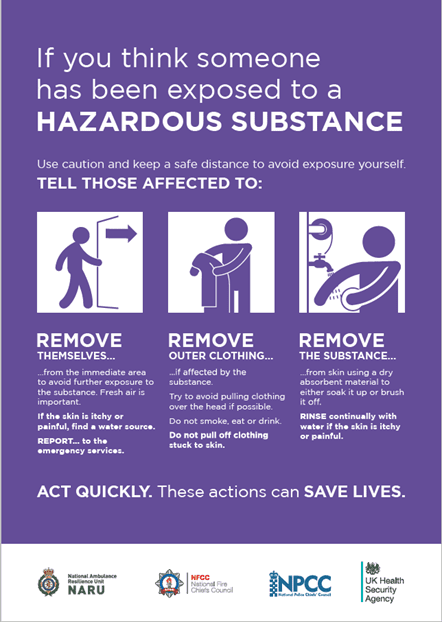If the incident involving hazardous substances does not involve any casualties, the signs that can be observed include:
- Unusual or out of context liquids, powders, vapours, smells or tastes
- Unusual or unattended materials, devices or equipment
If casualties are involved, physical symptoms can include:
- Disorientation
- Sweating
- Twitching and convulsions
- Airway irritation and breathing difficulties
- Eye and skin irritation
- Nausea and vomiting
If unprotected emergency responders observe incapacitated casualties without there being an explanation, they should not approach them, otherwise they may also become affected. However, emergency responders should attempt to determine what has occurred or is still happening, and report this to their control room.
Unprotected emergency responders can try to assist casualties without committing themselves into a contaminated area. Using public address systems or other methods of communication, they can provide casualties with advice and instructions.
If personnel are protected by wearing structural firefighting kit and breathing apparatus (BA), they can consider taking life-saving actions to rescue a casualty who is in line of sight.
People who have potentially been affected by CBRN materials should be instructed about how to follow the ‘REMOVE REMOVE REMOVE’ process, if they are able to do so:

By the time personnel arrive at the incident, people may already be leaving the hazard area, disrobing and carrying out improvised decontamination.
Fire control and on-scene personnel should liaise to:
- Establish what survival guidance should be provided to people at risk in a CBRN or explosive attack
- Ensure the survival guidance being given to people at risk reflects and supports the integrated multi-agency operational response plan
For further information about survival guidance for a terrorist attack refer to Survival guidance.
If fire control rooms are in contact with people at risk in a CBRN or explosive attack, they may be able to gather information about the incident and relay this to on-scene personnel, preferably to a nominated person in the command support function. They should ensure that providing the information does not put the caller at greater risk. On-scene personnel should relay any information gathered about the incident to the appropriate police commander; this could include information gained from calls to the fire control room or from other sources, such as witnesses to the incident.
Information about the suspected or potential CBRN(e) event should be gathered on arrival at the incident and provided to the fire control room. Updates on the situation should be provided at regular intervals and whenever further or updated information becomes available.
Incident commanders should liaise on a regular basis with National Inter-agency Liaison Officers (NILOs) and hazardous materials advisers if CBRN(e) hazards are involved, and consider any tactical advice provided by them. The NILO can advise if specialist teams are required; their attendance should be requested following National Resilience protocols.
JESIP principles should be applied, including effective situational reporting using the M/ETHANE model. This is vital to ensure that correct information is exchanged appropriately with all involved agencies, to support shared situational awareness.
For more information refer to:
- JESIP, Responding to a CBRN(e) event: Joint operating principles for the emergency services
- Protect.UK REMOVE. REMOVE. REMOVE: Guidance on hazardous substance exposure
- Hazardous materials – Chemical, Biological, Radiological, Nuclear and Explosive: CBRN(e)
- Hazardous materials – Chemical, Biological, Radiological, Nuclear (explosive) event
